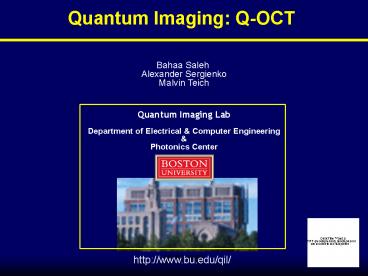Quantum Imaging Lab PowerPoint PPT Presentation
1 / 28
Title: Quantum Imaging Lab
1
Quantum Imaging Q-OCT
Bahaa Saleh Alexander Sergienko Malvin Teich
Quantum Imaging Lab Department of Electrical
Computer Engineering Photonics Center
http//www.bu.edu/qil/
2
Outline
- Quantum Imaging
- Two-Photon Imaging
- Quantum OCT
3
Outline
- Quantum Imaging
- Two-Photon Imaging
- Quantum OCT
4
Optical Imaging
Estimation of the spatial distribution (2D, 3D,
4D) of a physical object by use of optical
measurement (direct or interferometric)
Reflectance
R(x,y)
Source
Conventional Imaging Metrology
Detector
R(x,y,? )
or
Spectral or Hyperspectral Imaging
J(x,y)
or Jones matrix
Polarization-sensitive Imaging (Ellipsometry)
5
z
Source
R(z )
Ranging
or
Axial imaging
Detector
?(x,y,z)
or
3D Imaging Subsurface imaging
Imaging may involve spatial, spectral, and/or
polarization effects
6
Optical Lithography
Fabrication of objects with specified spatial
distributions (2D, 3D) by use of optical sources
and systems
Source
R(x,y)
Source
?(x,y,z)
7
Limitations of Optical Imaging Lithography
- Resolution (transverse axial)
8
Quantum Imaging
Estimation of the spatial distribution of a
physical object by use of light field in a
nonclassical state direct or Interferometric
measurement
9
Nonclassical States
States of Light
Coherent (laser imaging) Thermal (conventional,
photon-correlation imaging)
Quadrature-Squeezed Photon-Number
Squeezed Two-Photon Gaussian NOON
10
Outline
- Quantum Imaging
- Two-Photon Imaging
- Quantum OCT
11
Two-Photon light
?1
k1
?2
k?
a state of exactly two photons in multimodes
(spatial/spectral/polarization)
12
Two Configurations
A. Direct
B. Interferometric
H Spatial, spectral, or polarization system
13
A. Applications of Direct 2-Photon Imaging
14
1. Correlated-Photon Absolute Measurement
Measurement of reflectance/ Transmittance/
Quantum Efficiency
x
Sample
Klyshko, SJQE 77 Branning et al. PRA 00
15
2. Imaging (transverse) - Spatial modes
Belinskii Klyshko, Zh. Eksp. Teor. Fiz. 94
Pittman et al., PRA 95
16
3. Two-Photon Microscopy / Lithography
2-photon absorber
17
4. Dispersion Compensation
Hr(?)
C
Ho(?)
Franson PRA 1992
GVDs of opposite signs cancel
18
B. Applications of Interferometric 2-Photon
Imaging
19
Axial Imaging/Ranging
Spectral Modes
Hr(?)
C
Ho(?)
20
Outline
- Quantum Imaging
- Two-Photon Imaging
- Quantum OCT
21
Q-OCT Two-Photon Axial Imaging
c?
C(?)
H(?)
z
C(?)
Dispersion-Cancellation
?
Abouraddy et al. PRA, 053817, 2002
Hong-Ou-Mandel Interferometer
22
Experiment
ct
Detector
Filter
2.2 mm
55 mW
Filter
NLC 8-mm LiIO3
Detector
Sample
Nasr et al. PRL, 91, August 2003
23
Two Boundaries dispersive layer
90 ?m fused silica
Air
Air
53 ?m
Classical
Quantum
19 ?m
24
Four Boundaries dispersive medium in-between
AIR
AIR
12-mm
ZnSe
M. B. Nasr et al., Opt. Express 12, 1353-1362
(2004)
25
The Promise of Q-OCT
- Q-OCT promises x2 improved axial resolution in
comparison with conventional OCT for sources of
same spectral bandwidth - Self-interference at each boundary is immune to
GVD introduced by upper layers - Inter-boundary interference is sensitive to
dispersion of inter-boundary layers dispersion
parameters can thus be estimated - Preliminary experiments demonstrated viability
of technique - Technique can be extended to transverse imaging
(Q-OCM) - Technique can be extended to polarization-sensiti
ve Q-OCT
26
Q-OCT Challenges Plans
- State-of-the-art linewidth is not sufficiently
large - (Axial resolution is only 19 ?m).
- Two-photon flux is low. Duration of experiment
is too long. - A better 2-photon source is needed!
- Faster broadband single-photon detector is
needed! - Applications to scattering media (e.g., tissue).
- Theoretical experimental research is
necessary. - Algorithms for data processing need to be
developed.
27
Reprints
http//www.bu.edu/qil/
28
Comparison of OCT QOCT

